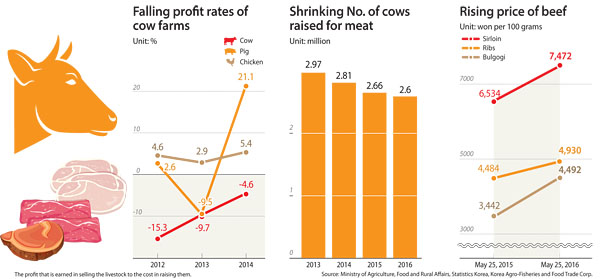Farmers worried at hanwoo prices

According to the Korea Agro-Fisheries and Food Trade Corporation, 100 grams (3 ounces) of top-quality hanwoo is sold at an average 7,472 won ($6.34). That’s 14.4 percent more expensive than a year ago.
The average retail price of hanwoo ribs has increased 9.9 percent year on year to 6,534 won, while the price of bulgogi, marinated beef, has surged 30.5 percent to 4,492 won.
Rising distribution costs are part of the reason hanwoo beef remains expensive, which accounts for roughly 42 percent of the retail price. There is also concern about shrinking supply of the grade-A beef.
In the first quarter alone, there were 2.65 million cows, including hanwoo, raised in Korea. The figure does not include diary cattle. The number of cows raised for consumption is 63,000, or 2.4 percent less than a year ago. While beef consumption continues to grow, the shrinking number of cows has been pushing up the retail prices.
The situation is expected to get worse. The Korea Rural Economic Institute forecast 194,000 hanwoo cows will be slaughtered between June and August. This is 14.5 percent or 226,000 cows fewer than the same period last year.
The government’s solution to stabilize the price of the premium beef is to encourage farmers to slaughter cows that are less than 30 months old. The government plans to offer 100,000 won for each cow that have been slaughtered before reaching 30 months.
But even this plan is considered temporary.
“As it is difficult to suddenly increase the number of cows for slaughtering, the high price [on hanwoo] will likely continue throughout the second half,” said an official at the Ministry of Agriculture, Food and Rural Affairs.
The root cause of the shortage of such premium beef dates back three or four years.
Between 2012 and 2013, the price of hanwoo beef had been falling, while many farms were faced with an increasing financial burden due to rising costs involving the price of feed and employee wages.
The hanwoo farm’s net profit rate was in the minus-10 percent range, meaning simply that the farms were losing money by raising the Korean cows.
This was largely because farms suddenly increased the number of hanwoo cows after the mad cow disease scare in 2008 drove Korean consumers to avoid imported beef, especially from North America.
In hopes of curbing the falling price of beef, the government introduced a policy of reducing the number of female cows.
The government paid between 300,000 and 500,000 won for each cow that was slaughtered in the hope of bringing down the number. Farms with their main businesses centered on raising cows for reproducing started to close down.
The result of the measures taken then is now being felt in households today.
Farms are hesitant to increase the number of cows they are raising largely because of the past experience where the price of hanwoo plummeted, prompting growing concerns that the price of hanwoo is expected to remain high for a long time.
Meanwhile, the consumption of imported beef is growing rapidly.
According to the Korea Agro-Fisheries and Food Trade Corporation, imported beef in the first four months of this year grew 10.9 percent from the same period a year ago to $753.8 million. By quantity, 133,065 tons of beef were imported, which is a 27.2 percent surge.
This is a surprisingly sharp expansion, considering that overall, agriculture and livestock imports including chicken and pork have actually decreased 5.6 percent during the same period.
“With the short-term measures that were employed in the past, the instability in the beef price will continue every three or four years,” said Ji In-bae, a researcher at Korea Rural Economic Institute. “One of the fundamental problem is that the farms that raise cows for reproduction, which are mostly small operations, continue to close businesses and then increase the number of reproductive cows [when business is good].
“[The government] needs to come up with more realistic and effective measures like the stable supply of calves.”
BY CHO HYUN-SOOK [lee.hojeong@joongang.co.kr]










with the Korea JoongAng Daily
To write comments, please log in to one of the accounts.
Standards Board Policy (0/250자)